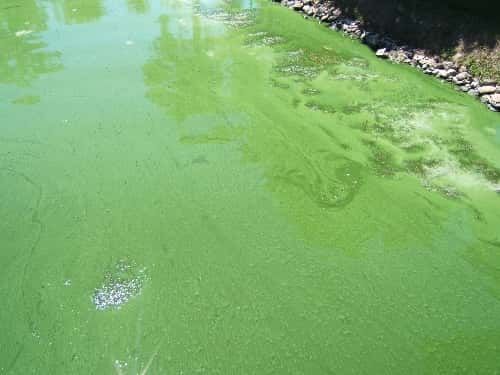
BISMARCK, N.D. (ND Dept. of Environmental Quality) – Hot summer weather contributes to the production of blue-green algae (cyanobacteria) in bodies of water that are used by people, pets and livestock.
Blue-green algae discolors the water and can cause foam, scum, or mats to appear on the surface. In severe cases, the water can have the appearance of spilled green paint or green pea soup.
Blue-green algae can also produce toxins in the water called cyanotoxins. People and animals that swallow water containing cyanotoxins can become sick with diarrhea and vomiting; numb lips, tingling fingers and toes; dizziness; or rashes, hives or skin blisters. In severe cases of exposure from ingesting contaminated water, cyanotoxins can result in death. There are no known antidotes for the cyanotoxins produced by blue-green algae. Children are at a higher risk than adults for illness because of their smaller size.
The North Dakota Department of Environmental Quality (NDDEQ) does test water for toxins and, if they are detected, issues advisories to the public. However, because it can take time to receive test results, people are urged to be cautious and avoid waters that look discolored, scummy, or have a foul odor.
According to Aaron Larsen with the NDDEQ Division of Water Quality, algae blooms are most common in North Dakota in late summer, however, it only takes a few hot days to cause the algae to bloom.
“Whether its cyanotoxins caused by blue-green algae or toxic water due to increased salts and sulfates, cattle can develop adverse clinical signs, including death,” says Dr. Michelle Mostrom with North Dakota State University’s Veterinary Diagnostic Lab.
Both the NDDEQ and the Department of Agriculture recommend these steps to avoid exposure to cyanotoxins:
- Respect advisories announced by public health authorities.
- Do not swim, water ski, or boat in areas where the water is discolored or where you see foam, scum or mats of green or blue-green algae on the water.
- If you accidentally swim in water that might have a cyanobacteria bloom, rinse off with fresh water as soon as possible.
- Do not let pets or livestock swim in or drink from areas where the water is discolored or where you see foam, scum, or mats of algae.
- If pets (especially dogs) swim in scummy water, rinse them off immediately – do not let them lick the algae (and toxins) off.
- Do not irrigate lawns or golf courses with pond water that looks scummy or smells bad.
For more information about the effects of blue-green algae blooms on pets and livestock, contact the North Dakota Department of Agriculture, Animal Health Division at 701.328.2655.
For more information on public health issues or to report a suspected blue-green algae bloom, go to the NDDEQ harmful algal blooms website https://deq.nd.gov/WQ/3_Watershed_Mgmt/8_HABS/Habs.aspx or contact the North Dakota Department of Environmental Quality, Division of Water Quality at 701.328.5210.
